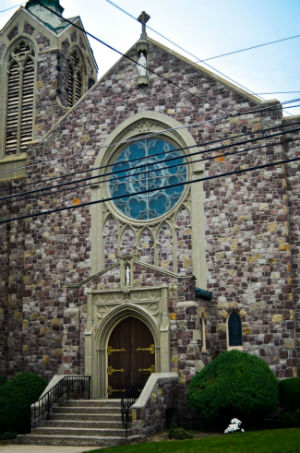Home »
St. Hedwig Church

St. Hedwig Church is a Tudor Gothic treasure tucked away on Erie's historic East Bayfront at Third and Wallace Streets. The church is a dark rose and beige faceted stone edifice embellished with sculpted Tudor tracery, with a heavy slate roof, and with a copper Gothic fleche presiding atop the bell tower. Adjoining the church from behind is a rectory which resembles a stately stone and brick English country house. Both look as though they flew over from England and perched on this gentle hillside.
The solid oak main doors of the church with genuine Tudor hinges open wide to welcome the visitor into a vestibule with polished brass chandeliers and from there into the nave of the church in order to join a procession of angels and archangels in the vault of the ceiling who march with lighted candles and swinging censers toward the heavenly liturgy which is to take place in the apse. Their way is illuminated by European stained-glass windows executed by Joseph Herzig of Munich in 1934. Saints beckon from the windows for the visitor to join them before the Trinity depicted by a mural on the back wall of the sanctuary showing God the Father holding his Son, the crucified Jesus, both united to each other in the bond of love which is the Holy Spirit.
The stone altar, which sits on a Gothic pedestal of singular beauty, rises from the sanctuary floor of antique ceramic tile of Italian vintage. Sitting above the tabernacle in front of the reredos is a hand carved 18th century baroque crucifix flanked by solid brass candlesticks founded in Germany. It is a rarity to see a tapestry as the reredos of an altar. This majestic piece presents the Virgin Mary with Child surrounded by angels on the main panel and below them the procession of saints gathered in heaven before the Trinity above them all. Likewise, in the arches of the ambulatory adjacent to the altar are tapestry figures of the four evangelists. The ambulatory itself is surmounted by intricate stone tracery capped by Tudor roses on the pinnacles. Not to be missed are the charming small art-deco angels hovering in the windows high on each side of the apse who inadvertently reveal the era of construction of the church in 1927.
As the visitor faces west to leave this noble house of God, which has snatched a piece of paradise from heaven, the great rose window with miniatures of countless saints becomes a giant globe of brightness in the afternoon sun. It reflects the celestial glory in which these saints there are clothed by the "unconquered sun", Jesus the Risen Lord, who is the triumphant end of our own earthly journey.
Contact information and driving directions
Erie's Tudor Gothic Jewel
* This beautiful description of the church was prepared by Bishop Lawrence E. Brandt, JCD, PhD. during his tenure at Saint Hedwig.
St. Hedwig Church is a Tudor Gothic treasure tucked away on Erie's historic East Bayfront at Third and Wallace Streets. The church is a dark rose and beige faceted stone edifice embellished with sculpted Tudor tracery, with a heavy slate roof, and with a copper Gothic fleche presiding atop the bell tower. Adjoining the church from behind is a rectory which resembles a stately stone and brick English country house. Both look as though they flew over from England and perched on this gentle hillside.
The solid oak main doors of the church with genuine Tudor hinges open wide to welcome the visitor into a vestibule with polished brass chandeliers and from there into the nave of the church in order to join a procession of angels and archangels in the vault of the ceiling who march with lighted candles and swinging censers toward the heavenly liturgy which is to take place in the apse. Their way is illuminated by European stained-glass windows executed by Joseph Herzig of Munich in 1934. Saints beckon from the windows for the visitor to join them before the Trinity depicted by a mural on the back wall of the sanctuary showing God the Father holding his Son, the crucified Jesus, both united to each other in the bond of love which is the Holy Spirit.
The stone altar, which sits on a Gothic pedestal of singular beauty, rises from the sanctuary floor of antique ceramic tile of Italian vintage. Sitting above the tabernacle in front of the reredos is a hand carved 18th century baroque crucifix flanked by solid brass candlesticks founded in Germany. It is a rarity to see a tapestry as the reredos of an altar. This majestic piece presents the Virgin Mary with Child surrounded by angels on the main panel and below them the procession of saints gathered in heaven before the Trinity above them all. Likewise, in the arches of the ambulatory adjacent to the altar are tapestry figures of the four evangelists. The ambulatory itself is surmounted by intricate stone tracery capped by Tudor roses on the pinnacles. Not to be missed are the charming small art-deco angels hovering in the windows high on each side of the apse who inadvertently reveal the era of construction of the church in 1927.
As the visitor faces west to leave this noble house of God, which has snatched a piece of paradise from heaven, the great rose window with miniatures of countless saints becomes a giant globe of brightness in the afternoon sun. It reflects the celestial glory in which these saints there are clothed by the "unconquered sun", Jesus the Risen Lord, who is the triumphant end of our own earthly journey.
Contact information and driving directions
